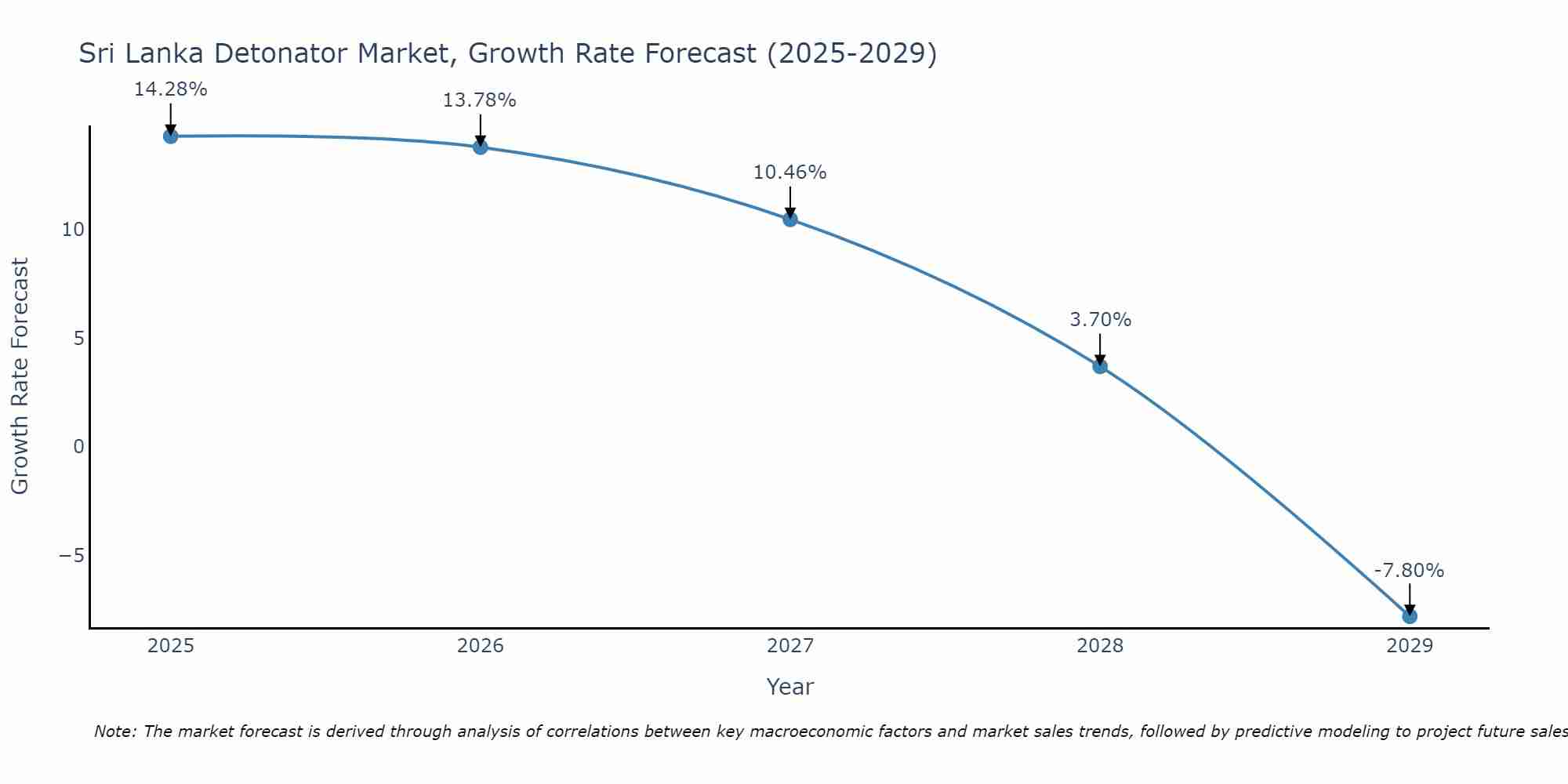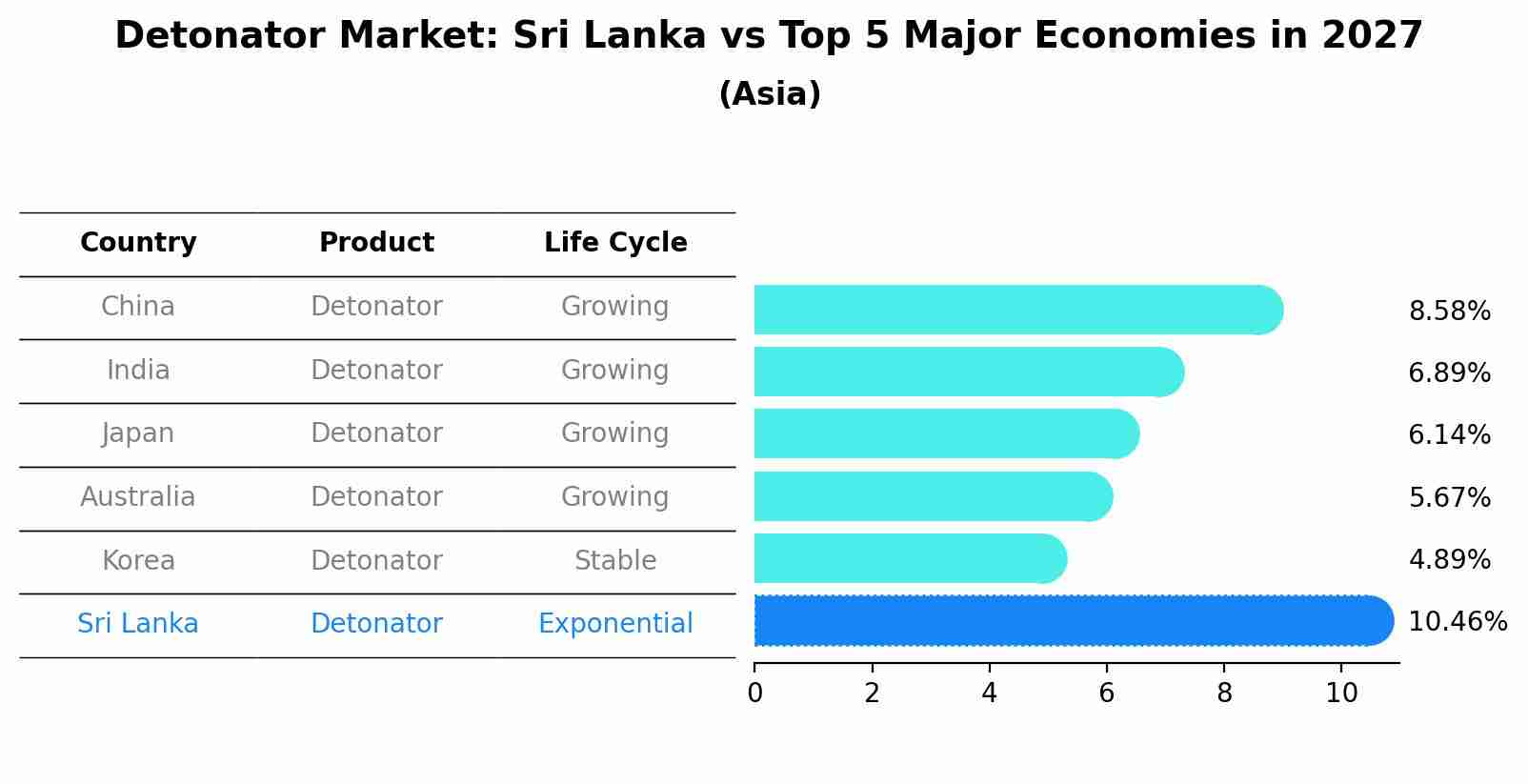Sri Lanka Detonator Market (2025-2031) Outlook | Size, Growth, Analysis, Industry, Trends, Value, Companies, Forecast, Revenue & Share
| Product Code: ETC418587 | Publication Date: Oct 2022 | Updated Date: Aug 2025 | Product Type: Market Research Report | |
| Publisher: 6Wresearch | No. of Pages: 75 | No. of Figures: 35 | No. of Tables: 20 | |
Sri Lanka Detonator Market Size Growth Rate
The Sri Lanka Detonator Market may undergo a gradual slowdown in growth rates between 2025 and 2029. Starting high at 14.28% in 2025, the market steadily declines to -7.80% by 2029.

Detonator Market: Sri Lanka vs Top 5 Major Economies in 2027 (Asia)
The Detonator market in Sri Lanka is projected to grow at a high growth rate of 10.46% by 2027, within the Asia region led by China, along with other countries like India, Japan, Australia and South Korea, collectively shaping a dynamic and evolving market environment driven by innovation and increasing adoption of emerging technologies.

Sri Lanka Detonator Market Overview
The detonator market in Sri Lanka is primarily driven by the mining and construction industries. Detonators are essential for controlled explosions in these sectors. The market is expected to grow as infrastructure development and mining activities increase. Safety regulations and technological advancements in detonator design and functionality are also influencing market dynamics.
Drivers of the market
The detonator market in Sri Lanka is primarily driven by infrastructure development projects such as mining, construction, and quarrying activities. Detonators are essential components in blasting operations for excavation and demolition purposes, with demand closely tied to the pace of construction and mining activities in the country.
Challenges of the market
The detonator market in Sri Lanka faces regulatory hurdles, safety concerns, and supply chain vulnerabilities. Strict regulations govern the manufacture, storage, and transportation of detonators due to safety risks associated with explosive materials. Ensuring compliance with international safety standards and enhancing local manufacturing capabilities are critical to meeting demand from industries such as mining and construction while mitigating risks associated with supply chain disruptions.
Government Policy of the market
The detonator market in Sri Lanka is strictly regulated by the Explosives Act and overseen by the Ministry of Defence. Government policies prioritize safety and security in the handling, storage, and transportation of detonators to prevent misuse and accidents. Regulatory authorities issue licenses and conduct regular inspections of manufacturers and users to enforce compliance with explosives regulations. Policies also address environmental concerns related to detonator disposal and promote training programs for safe handling practices.
Key Highlights of the Report:
- Sri Lanka Detonator Market Outlook
- Market Size of Sri Lanka Detonator Market, 2024
- Forecast of Sri Lanka Detonator Market, 2031
- Historical Data and Forecast of Sri Lanka Detonator Revenues & Volume for the Period 2021-2031
- Sri Lanka Detonator Market Trend Evolution
- Sri Lanka Detonator Market Drivers and Challenges
- Sri Lanka Detonator Price Trends
- Sri Lanka Detonator Porter's Five Forces
- Sri Lanka Detonator Industry Life Cycle
- Historical Data and Forecast of Sri Lanka Detonator Market Revenues & Volume By Type for the Period 2021-2031
- Historical Data and Forecast of Sri Lanka Detonator Market Revenues & Volume By Industrial electric detonators for the Period 2021-2031
- Historical Data and Forecast of Sri Lanka Detonator Market Revenues & Volume By Shock Tube Detonators for the Period 2021-2031
- Historical Data and Forecast of Sri Lanka Detonator Market Revenues & Volume By Application for the Period 2021-2031
- Historical Data and Forecast of Sri Lanka Detonator Market Revenues & Volume By Coal Mines for the Period 2021-2031
- Historical Data and Forecast of Sri Lanka Detonator Market Revenues & Volume By Metal Mines for the Period 2021-2031
- Historical Data and Forecast of Sri Lanka Detonator Market Revenues & Volume By Non-metal Mines for the Period 2021-2031
- Historical Data and Forecast of Sri Lanka Detonator Market Revenues & Volume By Railway/road for the Period 2021-2031
- Historical Data and Forecast of Sri Lanka Detonator Market Revenues & Volume By Hydraulic & Hydropower for the Period 2021-2031
- Sri Lanka Detonator Import Export Trade Statistics
- Market Opportunity Assessment By Type
- Market Opportunity Assessment By Application
- Sri Lanka Detonator Top Companies Market Share
- Sri Lanka Detonator Competitive Benchmarking By Technical and Operational Parameters
- Sri Lanka Detonator Company Profiles
- Sri Lanka Detonator Key Strategic Recommendations
Frequently Asked Questions About the Market Study (FAQs):
1 Executive Summary |
2 Introduction |
2.1 Key Highlights of the Report |
2.2 Report Description |
2.3 Market Scope & Segmentation |
2.4 Research Methodology |
2.5 Assumptions |
3 Sri Lanka Detonator Market Overview |
3.1 Sri Lanka Country Macro Economic Indicators |
3.2 Sri Lanka Detonator Market Revenues & Volume, 2021 & 2031F |
3.3 Sri Lanka Detonator Market - Industry Life Cycle |
3.4 Sri Lanka Detonator Market - Porter's Five Forces |
3.5 Sri Lanka Detonator Market Revenues & Volume Share, By Type, 2021 & 2031F |
3.6 Sri Lanka Detonator Market Revenues & Volume Share, By Application, 2021 & 2031F |
4 Sri Lanka Detonator Market Dynamics |
4.1 Impact Analysis |
4.2 Market Drivers |
4.2.1 Growing mining and quarrying activities in Sri Lanka driving the demand for detonators. |
4.2.2 Increasing construction and infrastructure development projects in the country. |
4.2.3 Rising demand for explosives in the defense and military sector. |
4.3 Market Restraints |
4.3.1 Stringent regulations and licensing requirements for the use of explosives. |
4.3.2 Environmental concerns and regulations related to the use of detonators. |
4.3.3 Fluctuations in raw material prices impacting the production costs of detonators. |
5 Sri Lanka Detonator Market Trends |
6 Sri Lanka Detonator Market, By Types |
6.1 Sri Lanka Detonator Market, By Type |
6.1.1 Overview and Analysis |
6.1.2 Sri Lanka Detonator Market Revenues & Volume, By Type, 2021-2031F |
6.1.3 Sri Lanka Detonator Market Revenues & Volume, By Industrial electric detonators, 2021-2031F |
6.1.4 Sri Lanka Detonator Market Revenues & Volume, By Shock Tube Detonators, 2021-2031F |
6.2 Sri Lanka Detonator Market, By Application |
6.2.1 Overview and Analysis |
6.2.2 Sri Lanka Detonator Market Revenues & Volume, By Coal Mines, 2021-2031F |
6.2.3 Sri Lanka Detonator Market Revenues & Volume, By Metal Mines, 2021-2031F |
6.2.4 Sri Lanka Detonator Market Revenues & Volume, By Non-metal Mines, 2021-2031F |
6.2.5 Sri Lanka Detonator Market Revenues & Volume, By Railway/road, 2021-2031F |
6.2.6 Sri Lanka Detonator Market Revenues & Volume, By Hydraulic & Hydropower, 2021-2031F |
7 Sri Lanka Detonator Market Import-Export Trade Statistics |
7.1 Sri Lanka Detonator Market Export to Major Countries |
7.2 Sri Lanka Detonator Market Imports from Major Countries |
8 Sri Lanka Detonator Market Key Performance Indicators |
8.1 Number of new mining and quarrying permits issued in Sri Lanka. |
8.2 Growth in the number of construction permits granted in the country. |
8.3 Percentage increase in defense and military spending in Sri Lanka. |
8.4 Compliance rate with environmental regulations related to explosive use. |
8.5 Cost of key raw materials used in detonator production. |
9 Sri Lanka Detonator Market - Opportunity Assessment |
9.1 Sri Lanka Detonator Market Opportunity Assessment, By Type, 2021 & 2031F |
9.2 Sri Lanka Detonator Market Opportunity Assessment, By Application, 2021 & 2031F |
10 Sri Lanka Detonator Market - Competitive Landscape |
10.1 Sri Lanka Detonator Market Revenue Share, By Companies, 2024 |
10.2 Sri Lanka Detonator Market Competitive Benchmarking, By Operating and Technical Parameters |
11 Company Profiles |
12 Recommendations |
13 Disclaimer |
- Single User License$ 1,995
- Department License$ 2,400
- Site License$ 3,120
- Global License$ 3,795
Search
Related Reports
- Vietnam System Integrator Market (2025-2031) | Size, Companies, Analysis, Industry, Value, Forecast, Growth, Trends, Revenue & Share
- ASEAN and Thailand Brain Health Supplements Market (2025-2031) | Strategy, Consumer Insights, Analysis, Investment Trends, Opportunities, Growth, Size, Share, Industry, Revenue, Segments, Value, Segmentation, Supply, Forecast, Restraints, Outlook, Competition, Drivers, Trends, Demand, Pricing Analysis, Competitive, Strategic Insights, Companies, Challenges
- ASEAN Bearings Market (2025-2031) | Strategy, Consumer Insights, Analysis, Investment Trends, Opportunities, Growth, Size, Share, Industry, Revenue, Segments, Value, Segmentation, Supply, Forecast, Restraints, Outlook, Competition, Drivers, Trends, Demand, Pricing Analysis, Competitive, Strategic Insights, Companies, Challenges
- Europe Flooring Market (2025-2031) | Outlook, Share, Industry, Trends, Forecast, Companies, Revenue, Size, Analysis, Growth & Value
- Saudi Arabia Manlift Market (2025-2031) | Outlook, Size, Growth, Trends, Companies, Industry, Revenue, Value, Share, Forecast & Analysis
- Uganda Excavator, Crane, and Wheel Loaders Market (2025-2031) | Strategy, Consumer Insights, Analysis, Investment Trends, Opportunities, Growth, Size, Share, Industry, Revenue, Segments, Value, Segmentation, Supply, Forecast, Restraints, Outlook, Competition, Drivers, Trends, Demand, Pricing Analysis, Competitive, Strategic Insights, Companies, Challenges
- Rwanda Excavator, Crane, and Wheel Loaders Market (2025-2031) | Strategy, Consumer Insights, Analysis, Investment Trends, Opportunities, Growth, Size, Share, Industry, Revenue, Segments, Value, Segmentation, Supply, Forecast, Restraints, Outlook, Competition, Drivers, Trends, Demand, Pricing Analysis, Competitive, Strategic Insights, Companies, Challenges
- Kenya Excavator, Crane, and Wheel Loaders Market (2025-2031) | Strategy, Consumer Insights, Analysis, Investment Trends, Opportunities, Growth, Size, Share, Industry, Revenue, Segments, Value, Segmentation, Supply, Forecast, Restraints, Outlook, Competition, Drivers, Trends, Demand, Pricing Analysis, Competitive, Strategic Insights, Companies, Challenges
- Angola Excavator, Crane, and Wheel Loaders Market (2025-2031) | Strategy, Consumer Insights, Analysis, Investment Trends, Opportunities, Growth, Size, Share, Industry, Revenue, Segments, Value, Segmentation, Supply, Forecast, Restraints, Outlook, Competition, Drivers, Trends, Demand, Pricing Analysis, Competitive, Strategic Insights, Companies, Challenges
- Israel Intelligent Transport System Market (2025-2031) | Strategy, Consumer Insights, Analysis, Investment Trends, Opportunities, Growth, Size, Share, Industry, Revenue, Segments, Value, Segmentation, Supply, Forecast, Restraints, Outlook, Competition, Drivers, Trends, Demand, Pricing Analysis, Competitive, Strategic Insights, Companies, Challenges
Industry Events and Analyst Meet
Our Clients
Whitepaper
- Middle East & Africa Commercial Security Market Click here to view more.
- Middle East & Africa Fire Safety Systems & Equipment Market Click here to view more.
- GCC Drone Market Click here to view more.
- Middle East Lighting Fixture Market Click here to view more.
- GCC Physical & Perimeter Security Market Click here to view more.
6WResearch In News
- Doha a strategic location for EV manufacturing hub: IPA Qatar
- Demand for luxury TVs surging in the GCC, says Samsung
- Empowering Growth: The Thriving Journey of Bangladesh’s Cable Industry
- Demand for luxury TVs surging in the GCC, says Samsung
- Video call with a traditional healer? Once unthinkable, it’s now common in South Africa
- Intelligent Buildings To Smooth GCC’s Path To Net Zero













